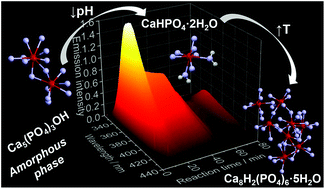Abstract
In this work, in situ luminescence analysis was applied for the first time for monitoring the phase transitions of calcium phosphate (CaP) and confirmed by synchrotron in situ X-ray diffraction in addition to in situ infrared spectroscopy, with simultaneous measurements of pH and ion conductivity. Applying doped Ce3+ and Eu3+ as local coordination sensors, the high sensitivity of their emission spectra upon the changes in the coordination sphere of the doped cation sites enabled to detect the formation of amorphous calcium phosphate (ACP) and Ca5(PO4)3OH, besides their subsequent transitions to CaHPO4·2H2O and Ca8H2(PO4)6·5H2O under real reaction conditions. Calcium phosphates are widely present in mammals and understanding their phase transitions is important to comprehend the conversion between healthy and diseased tissues. In situ luminescence measurements are advantageous for allowing monitoring these phase transitions in a fast and sensitive fashion also in conventional laboratories, independent of synchrotron radiation.

- This article is part of the themed collection: Inorganic Chemistry Frontiers HOT articles for 2017


 Please wait while we load your content...
Please wait while we load your content...